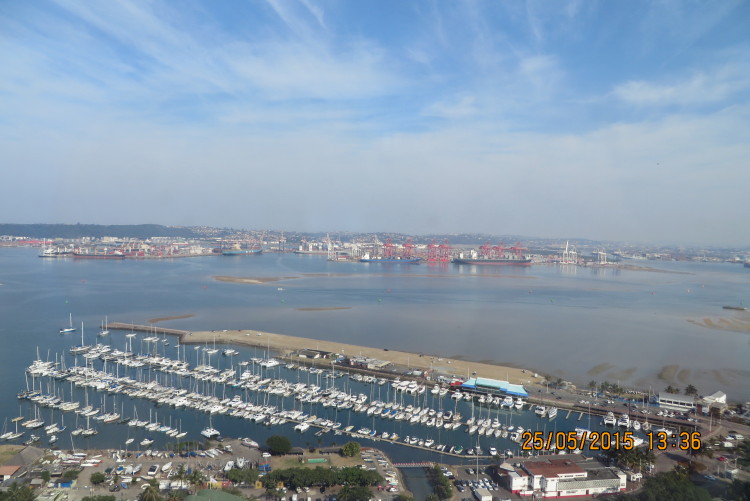Recent developments
There have been reported groundings, including two recent incidents at the harbour entrance to the port of Durban. In the first case it was reported that MV Pacific Quartz touched the north breakwater and the second vessel MV ER Elsfleth touched bottom in early December. The port authorities are investigating the incidents, but the second incident is alarming as reports may indicate that there appears to be a sand bar forming across the harbour entrance.
Questions have been raised at various local forums regarding these incidents and various theories have been put forward. The most pertinent one regards proper dredging of the entrance channel and the removal of silt from the South breakwater.
The harbour master is expected to publish a report shortly on the issue of dredging as there may have already been a number of previous groundings in the port. As a result of these groundings, the port reduced the under keel clearance in Durban by 30 cm as reported in a previous loss prevention notice dated 30 September 2014.

Legal issues
Warranty
Members are reminded that should the wording in the charterparty expressly state that the vessel will be employed between "safe ports and safe places" (NYPE 93, clause 5) or similar such wording, then an express warranty of safety is created and charterers may be liable to owners for damages sustained as a result of an unsafe port or berth.
It needs to be kept in mind of course that in other charter terms, say Shelltime 4, the basic obligation is one of due diligence, rather than an absolute warranty.
The classic definition of an unsafe port is:
"...a port will not be safe unless, in the relevant period of time, the particular ship can reach it, use it and return from it without, in the absence of some abnormal occurrence, being exposed to danger which cannot be avoided by good navigation and seamanship..." (The Eastern City [1958]).
When one considers the reported incidents at the Port of Durban, it will be necessary to put these in to the context of this legal test as well as the factual circumstances of each case. Dredging could be a port safety issue, especially if it is systematic, as could the build-up of silt and cargo residues at berths. Equally there will be a focus on the good navigation and seamanship of any given vessel, particularly if there are known issues which could be avoided by the exercise of the same.
Obligation
The issues presently experienced in the Port of Durban have been highly publicised in the media and members are strongly encouraged to obtain up to date information on the situation, in particular, the draft restrictions and tide before orders are given to the master and prior to arrival within the port limits.
Members are advised to ensure that up to date charts are on board and the latest information on tides, vessel restrictions and keel clearance is obtained. Charterers are advised not to simply ascertain when orders are given to sail to Durban the conditions then but to continue to make enquiries whilst vessel is sailing towards the port. Circumstances can change from the time orders are given to arrival at the pilot station and members are encouraged to ensure as much information as possible is obtained and up to date.
Defences
From information available to the Association it would appear that there have been a number of incidents at the Port of Durban, relating to touch bottom incidents and groundings since September 2014 and perhaps before. It will be a question for the facts of each individual case as to whether a port safety issue arose or whether another factor is in play.
While frequency of an incident alone is not a determining factor, the repeat occurrence of an event linked to the same underlying factual issues may indicate that there is a systemic problem. System failures can mean there is a port safety issue, although again it will be necessary to consider each incident on its own facts.
Where there is a positive allegation, based on facts, that there is a port safety issue it will be for the charterer to put forward a defence that demonstrates that the allegation is not made out, either because the facts do not actually bear out such a case or because the legal requirements of the established test are not actually met.
Charterers should also be aware that just because an owner has agreed to proceed to any particular port, that does not mean the owner has necessarily waived the right to claim that there is a safety issue or the right to claim damages.
Advice
Members are again advised to be aware of the vessel's full dimensions and to make regular enquiries with agents in Durban especially for vessels with drafts in excess of 10 m. It is further recommended that enquiries are made as to dredging activities in the port prior to reaching port limits.
If in doubt, prompt contact should be made with the Association's correspondents.
Previous advice
The Association has previously given advice on such issues. Members are referred to the Club's notice dated 30 September 2014 and the legal advice regarding charterers defences for unsafe ports and/or berths dated 10 February 2014.
The Association is grateful to Messrs. P&I Associates (Pty) Ltd of Durban, South Africa for contributing to this update.